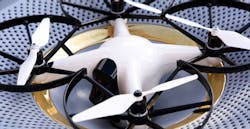LandSkyAI CEO on Drones and the Future of Perimeter Security
Faced with rising labor costs and growing coverage demands, many organizations are evaluating whether autonomous drones can enhance or replace traditional guard patrols. In this Executive Q&A, SecurityInfoWatch interviews Jake Shild, founder and CEO of LandSkyAI, about how the company’s remote-piloted drone platform integrates with existing security systems, supports real-time alarm response, and creates recurring revenue opportunities for integrators. Shild also outlines key factors end users should consider when deciding if drone patrol is the right fit for their perimeter strategy, and shares insight into the markets seeing the strongest adoption.
What types of security systems can your autonomous drone solution integrate with, and how is that integration typically achieved in the field?
Our drone platform is designed to slot into an organization’s existing security ecosystem without requiring a complete overhaul. Video streams can be shared via RTSP or through an ONVIF‑compliant server, allowing most video management systems to treat the drone feed just like any other IP camera. For intrusion detection or access control systems, we offer lightweight bridge devices or API/webhook connections so that an alarm event can automatically trigger a drone launch, and once the drone verifies the situation, it can push a “clear” or “verify” signal back to the client’s monitoring dashboard.
In practice, the integrator ties a wired link from the drone enclosure into the customer’s network, configures RTSP/ONVIF endpoints in the VMS, and sets up any necessary internal API credentials for alarm panels or access control triggers. Once configured, the drone behaves just like another camera or sensor within an integrated security architecture.
What are the key operational advantages of remote-piloted drones versus traditional on-site patrols or manned guard services?
Drones launch in seconds and can complete a perimeter sweep in under two minutes, covering large or difficult‑to‑navigate areas far more quickly than a guard on foot or in a vehicle. Since drones follow predefined flight paths and maintain consistent video quality (HD and thermal), they eliminate gaps in coverage caused by guard fatigue, shift changes or restricted sightlines. This consistency also creates a reliable audit trail, every flight’s telemetry and video feed is logged for easy incident review, whereas manual patrol logs can be inconsistent.
From a cost perspective, once the hardware and pilot staffing are in place, drone patrols generally run 30% to 50% cheaper than comparable guard contracts, especially when accounting for overtime, insurance and liability associated with on‑site personnel. Drones also respond faster: instead of a guard taking four to six minutes to reach a triggered alarm point, a drone can arrive much faster. By handling routine patrols, drones free up security staff to focus on analysis, decision‑making, and tasks that truly require on‑site presence.
What integrators need to know about deployment
Can you walk us through a typical deployment — from initial site assessment to go-live — and what role the integrator plays in that process?
Deployment begins with a thorough site assessment: we analyze applicable airspace restrictions, evaluate perimeter vulnerabilities, and map network/power requirements for the drone base station. Next, we conduct a mapping mission, using an enterprise drone system, to generate a centimeter‑accurate 3D model of the facility. While the mapping is under way, we file any required FAA waivers or local flight permits, and collaborate with municipal authorities as needed.
Once power and network connectivity are confirmed and a secure takeoff/landing pad is identified, we deliver pre‑configured enclosure hardware. On the install day, integrators support our installation, cable runs, and firewall configurations so the drone’s RTSP/ONVIF endpoints can feed into the customer’s VMS. We then commission the system, uploading mission plans, verifying alarm‑to‑launch sequences, and training operators on basic mission overrides. The integrator remains the primary liaison, responsible for physical installation, first‑line troubleshooting, and ensuring that the drone platform ties seamlessly into the broader security infrastructure.
How do you ensure FAA compliance across different jurisdictions, especially for clients with multiple facilities or national footprints?
We treat each location as its own operational footprint. For every facility, we file FAA waivers (Part 107 or COA) based on that site’s exact GPS coordinates, ensuring flights stay within approved airspace and altitude limits. The drone’s firmware enforces geo‑fences and altitude caps; if an operator attempts to cross a boundary, the aircraft will hover and alert the pilot to prevent unauthorized flights. Additionally, the system has a built-in ADS-B receiver in the base station to monitor local air traffic and automatically receives an air notices. For sites near controlled airspace, we work directly with local Flight Standards District Offices or airport authorities to secure any extra permissions required.
To keep clients up to date, we keep a Site‑Specific Operations Manual detailing local restrictions, emergency procedures, and compliance checklists. We track any relevant FAA rule changes or Notices to Air Missions (NOTAMs) that could affect operations. This centralized tracking, combined with on‑device geo‑fencing, ensures that every facility maintains uninterrupted, legal drone patrol coverage.
What are the top considerations for end users when deciding whether drone patrol is a fit for their perimeter security strategy?
First, evaluate site size and complexity. Drone solutions excel at covering large open areas, hundreds of acres, sprawling industrial yards, or remote perimeters, far more efficiently than fixed cameras or guards on foot. If your facility has hard‑to‑reach zones, uneven terrain, or extended fence lines, drones often deliver greater coverage at lower incremental cost.
Second, consider existing security spend and integration readiness. If you already pay for around‑clock guard shifts or have an extensive infrastructure for a perimeter fixed‑camera network, introducing drones can reduce those labor and equipment costs by 30–50%. Finally, factor in regulatory and safety considerations: Inspections of hazardous or poorly lit areas drive even higher ROI because drones remove human exposure to risk.
Evaluating the fit and ROI for end users
Are there measurable ROI metrics or case study results you can share that help quantify the cost-benefit of autonomous patrols?
Many clients report greater reductions in patrol labor cost within the first year. False alarm rates also decline dramatically because drones can verify alarms before dispatching authorities or guards, saving time and reducing unnecessary call‑outs.
On the response‑time side, customers often see the time from alarm trigger to first video feed drop to under two minutes (when a drone is dispatched). Some facilities have even seen intrusions fall down to zero once a drone patrol is active. Some clients are even looking into decreases in insurance premiums by the added safety benefits.
What can security integrators expect from your partner program in terms of recurring revenue, technical support and training resources. And how does the program position them to offer drone security as a turnkey service to their customers?
Integrators participate in a subscription model where they earn a margin on every LandSky as a service contract (covering drone hardware, pilot staffing, cloud analytics, preventative maintenance and more). Since hardware refreshes and preventive maintenance are included, integrators carry minimal upfront capital and can quickly scale recurring revenue as clients add new sites or upgrade payloads. As a result, the subscription becomes a predictable, dependable ARR stream.
On the support and enablement front, integrators receive a dedicated technical liaison, access to a 24/7 remote operations center for drone health monitoring, and tiered escalation paths that guarantee same‑day or next‑day assistance as needed. Training is delivered through quarterly “Integrator Bootcamps,” an online partner portal with mission templates and best‑practice playbooks. All of these resources allow integrators to quickly bring drone patrol to market, even if they have limited prior experience, effectively turning drone security into a turnkey offering for their customers.
How do you support integrator partners in identifying the right customers and applications for drone deployment, and what types of use cases or vertical markets are currently showing the strongest demand?
We arm integrators with playbooks, for manufacturing sites, critical infrastructure, logistics hubs, campus environments, and event security, that outline typical threat profiles, recommended mission plans, sales strategies, procurement processes, and ROI projections. These playbooks include anonymized performance data (cost savings, false alarm reductions) from comparable installations, helping integrators rapidly build a business case and tailor proposals to each prospect’s unique needs.
Right now, the strongest demand is coming from sectors such as industrial and manufacturing facilities, critical infrastructure like utilities and pipelines, logistics and warehouse complexes, ultra-high-net-worth (UHNW) and luxury residential properties, as well as sports venues and large public events.
About the Author
Rodney Bosch
Editor-in-Chief/SecurityInfoWatch.com
Rodney Bosch is the Editor-in-Chief of SecurityInfoWatch.com. He has covered the security industry since 2006 for multiple major security publications. Reach him at [email protected].


